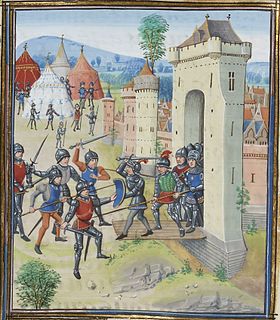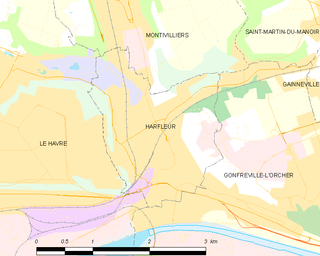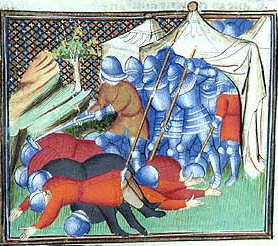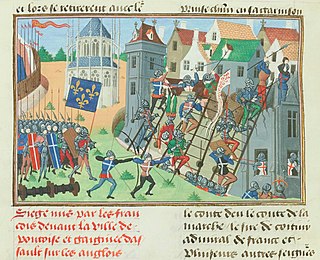 W
WThe siege of Aiguillon, an episode in the Hundred Years' War, began on 1 April 1346 when a French army commanded by John, Duke of Normandy, laid siege to the Gascon town of Aiguillon. The town was defended by an Anglo-Gascon army under Ralph, Earl of Stafford.
 W
WThe siege of Calais occurred at the conclusion of the Crécy campaign, when an English army under the command of King Edward III of England successfully besieged the French town of Calais during the Edwardian phase of the Hundred Years' War.
 W
WThe siege of Calais between June and July 1436 was a failed siege of English-held Calais by Philip the Good, Duke of Burgundy, and Flemish militia.
 W
WThe siege of Compiègne (1430) was conducted by Duke Philip III of Burgundy after the town of Compiègne had refused to transfer allegiance to him under the terms of a treaty with Charles VII. The siege is perhaps best known for Joan of Arc's capture by Burgundian troops while accompanying an Armagnac force during a skirmish outside the town on 23 May 1430. Although this was otherwise a minor siege, both politically and militarily, and ultimately ended in a defeat for the Burgundians, the capture of Joan of Arc was an important event of the Hundred Years' War.
 W
WThe Crécy campaign was a series of large-scale raids (chevauchées) conducted by the Kingdom of England throughout northern France in 1346 that devastated the French countryside on a wide front, culminating in the eponymous Battle of Crécy. The campaign was part of the Hundred Years' War.
 W
WThe Siege of Dieppe took place during the Hundred Years War. English forces led by John Talbot, Earl of Shrewsbury besieged and failed to capture the French-held port of Dieppe in Normandy.
 W
WThe siege of Guînes took place from May to July 1352 when a French army under Geoffrey de Charny unsuccessfully attempted to recapture the French castle at Guînes which had been seized by the English the previous January. The siege was part of the Hundred Years' War and marked the resumption of full-scale hostilities after six years of an uneasy and ill-kept truce.
 W
WThe siege of Harfleur was conducted by the English army of King Henry V in Normandy, France, during the Hundred Years' War. The defenders of Harfleur surrendered to the English on terms and were treated as prisoners of war. The English army was considerably reduced by casualties and an outbreak of dysentery during the siege but marched towards Calais, leaving a garrison behind at the port. The English were intercepted en route and fought the Battle of Agincourt, inflicting a huge defeat on the French.
 W
WThe siege of Hennebont of 1342 was an episode of the succession of the War of Bretagne. The forces of Charles of Blois kept Jeanne of Flandre in the city, while they waited for English reinforcements. The arrival of these reinforcements in June 1342 provoked the lifting of the siege.
 W
WEnglish offensives in 1345–1347, during the Hundred Years' War, resulted in repeated defeats of the French, the loss or devastation of much French territory and the capture by the English of the port of Calais. The war had broken out in 1337 and flared up in 1340 when the king of England, Edward III laid claim to the French crown and campaigned in northern France. There was then a lull in the major hostilities, although much small-scale fighting continued.
 W
WThe Siege of León of 1368 was a successful siege of the city by the pretender Henry of Trastámara, in the course of the Castilian Civil War.
 W
WThe town of Limoges had been under English control but in August 1370 it surrendered to the French, opening its gates to the Duke of Berry. The Siege of Limoges was laid by the English army led by Edward the Black Prince in the second week in September. On 19 September, the town was taken by storm, followed by much destruction and the deaths of numerous civilians. The sack effectively ended the Limoges enamel industry, which had been famous across Europe, for around a century.
 W
WThe siege of Meaux was fought in 1421-1422 between the English and the French during the Hundred Years' War. The English were led by King Henry V. Henry became ill while fighting this long battle, which took place during the winter months. He died on 31 August as a result.
 W
WThe Siege of Montargis took place during the Hundred Years War. A French relief army under Jean de Dunois routed an English force led by the Earl of Warwick.
 W
WThe siege of Orléans was the watershed of the Hundred Years' War between France and England. It was the French royal army's first major military victory to follow the crushing defeat at the Battle of Agincourt in 1415, and also the first while Joan of Arc was with the army. The siege took place at the pinnacle of English power during the later stages of the war. The city held strategic and symbolic significance to both sides of the conflict. The consensus among contemporaries was that the English regent, John of Lancaster, would have succeeded in realizing his brother the English king Henry V's dream of conquering all of France if Orléans fell. For half a year the English and their French allies appeared to be winning, but the siege collapsed nine days after Joan's arrival.
 W
WThe siege of Paris was an assault undertaken in September 1429 during the Hundred Years' War by the troops of the recently crowned King Charles VII of France, with the notable presence of Joan of Arc, to take the city held by the English and the Burgundians. King Charles's French troops failed to enter Paris, defended by the governor Jean de Villiers de L'Isle-Adam and the provost Simon Morhier, with the support of much of the city's population.
 W
WThe Siege of Pontoise took place during the Hundred Years War. French forces led by King Charles VII of France besieged and captured the last English stronghold in Île de France, eliminating the English threat to Paris.
 W
WThe siege of Rouen was a major event in the Hundred Years' War, where English forces loyal to Henry V captured Rouen, the capital of Normandy, from the Norman French.
 W
WThe siege of Tartas in Gascony was an engagement between English and French forces in the late stages of the Hundred Years' War. It was undertaken by English forces and their Gascon subjects against Charles II of Albret, a powerful nobleman in southwestern France. Albret was hostile to the English and his presence in Gascony caused much trouble to the English in the region, thereby raising the need to strike against him. The bulk of hostilities only lasted up until early 1441: the siege had dragged on inconclusively, and peace terms were agreed between the attackers and defenders. The ceasefire was extended several times until mid-1442 as both sides awaited further support from England and France.
 W
WThe sieges of Vannes of 1342 were a series of four sieges of the town of Vannes that occurred throughout 1342. Two rival claimants to the Duchy of Brittany, John of Montfort and Charles of Blois, competed for Vannes throughout this civil war from 1341 to 1365. The successive sieges ruined Vannes and its surrounding countryside. Vannes was eventually sold off in a truce between England and France, signed in January 1343 in Malestroit. Saved by an appeal of Pope Clement VI, Vannes remained in the hands of its own rulers, but ultimately resided under English control from September 1343 till the end of the war in 1365.